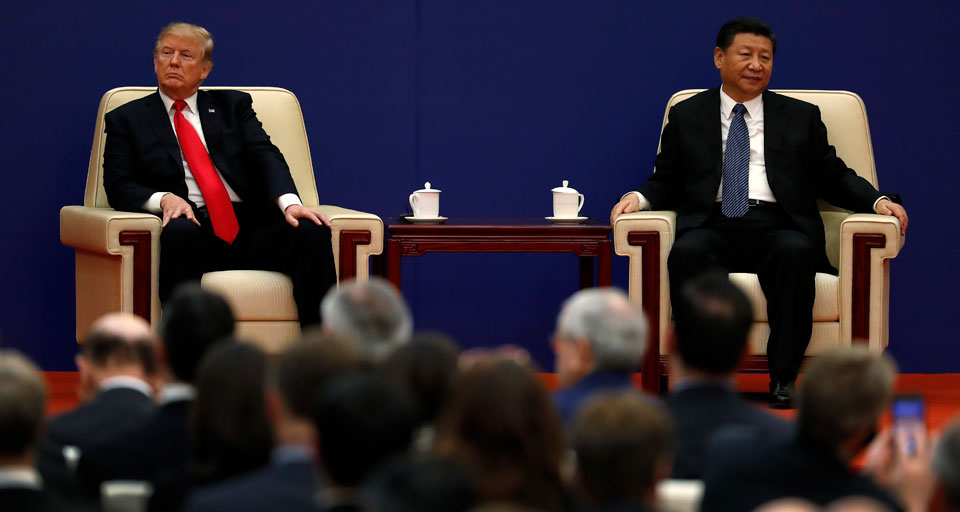
“Trade is a zero-sum game.” “There can only be one winner and one loser, and the United States is losing.” That’s the message Donald Trump has been hammering since before he even came into office. The biggest villain in his nationalist nightmares, beating and cheating the U.S. in the cutthroat game of global economics? China, of course.
The narrative used to justify his escalating tariff war goes something like this: The trade deficit is out of control because China plays dirty. It keeps U.S. products out of its domestic market, undervalues its currency in order to sell things cheaper, subsidizes its state-owned companies, and steals “our” technology to improve its own products.
He promises that higher tariffs, which to put it simply are really just increased taxes on imports, will knock some sense into the Chinese and show them America won’t be bullied. Attempting to rally his flagging political base, he claims to wage his trade battle on behalf of the American worker, vowing never to back down until “Beijing stops cheating our workers and stealing our jobs.”
Doing it for the workers?
The same game has been played by managers and bosses forever. They try to get their workers to identify their interests with those of the company and compete with other companies and other workers. We’re all on the same team here, don’t you know?
It’s troubling when some, like Teamsters union leader James Hoffa, Jr., repeat Trump’s message. Speaking on PBS recently, he echoed the rhetoric of the president, saying: “We need tariffs against China…to level the playing field…. They’ve had it one way all this time…. They have really kind of gone wild over there. And we have got to get them back to our senses.”
The oversimplified explanation that Trump gives, and which sounds appealing on the surface, is that the country will be making money in the short run from Chinese tariff payments and will have more jobs in the long run when China finally cracks. But the reality is, that just isn’t how capitalism works and it’s not how this trade war is shaking out.
The latest calculations from researchers at UCLA show that the American consumer bore the full brunt of increased import taxes in 2018, amounting to nearly $69 billion, or an average of $213 per person. If you bought a new car or washing machine last year, you probably went well over that average. U.S. companies just passed the cost on to all of us.
And the real kicker for those who believed Trump’s trade rhetoric? The UCLA team concluded that “workers in heavily Republican counties were the most negatively affected by the trade war.” The impact has been harshest for farmers in some of those same counties. They have watched helplessly as Chinese markets for their soybeans and other crops evaporated in response to U.S. tariffs, while the costs of their tractors went up.

For the average American worker and farmer, the trade war has so far been a bust. So why is Trump really engaging in this economic brinksmanship with China, and why now?
Why China? Why now?
Like the shrewd businessman he portrays on TV, Trump has pursued a strategy of first bluffing, then threatening, and finally striking a blow until his competitor caves in and cuts a deal. But China is not some small, weak country easily intimidated into following U.S. dictates; it’s the second-largest economy in the world. And that fact is precisely why China is being targeted now.
It would be a mistake, however, to think it’s only Trump who wants to knock China down a peg or two. Though his reckless tactics and erratic declarations make many Wall Street investors and futures traders nervous, the goal of containing China’s economic development is one shared across the U.S. capitalist class.
For a long time, China has been the world’s low-wage workshop. As a poorer developing country in the late 1970s, China had little choice but to open itself to foreign investors looking for cheap labor.
Its factories kept the shelves stocked at Walmart, and in return, the United States sold China tech-intensive goods like airplanes and computer parts. China benefitted from the investment, obviously, but whether it was imports or exports, most of the profits usually flowed toward U.S. companies.
But some things are starting to change. China is building the basis for its own high-tech economy and no longer needs to just be a manufacturer of textiles and plastic goods. Chinese solar panels now dominate the world market for renewables, Huawei phones compete globally with older brands like Apple and Samsung, and Weibo’s 462 million monthly users dwarf Twitter’s 270 million.

In the nearly 75 years since the end of World War II, U.S. imperialism has had no real competitors in the capitalist world. Only the Soviet Union presented a challenge, but it has been gone for over a quarter-century already. China’s rapid growth and development—especially its ambitious “Made in China 2025” plan and its effort to build an international alternative to U.S-dominated trade with its “Belt and Road Initiative”—promises to reset everything.
But one thing hasn’t changed: Capitalist states always aim to dominate markets, control resources, and secure new outlets and locations for investment on behalf of their firms. Trump’s tariff war is one aspect of the effort to block China’s ascent into fully-developed status; the U.S. military’s campaign of encircling China—represented most clearly by former President Barack Obama’s “pivot to Asia”—is another.
The U.S. capitalist state wrote the rules by which the world economy functions; it set up and maintains control of the primary institutions governing international trade. There is still no one—no one—with the capacity to bully or economically overpower the U.S.
As for our domestic troubles, the U.S.-China trade deficit is not the main danger threatening the U.S. economy. Graver problems are a public spending regime that showers billions on the military; underfunded education, health, and social services that are starved by tax cuts for the rich; crumbling infrastructure; the refusal of right-wing politicians and corporations to raise wages; and gender and racial pay gaps that maintain systemic sexism and racism.
China, meanwhile, uses its state-owned enterprises, control over finance, regulation of foreign investment, and—yes—smart tariffs to foster strong companies and lay a basis for raising standards of living (and make a lot of money for Chinese capitalists along the way, no doubt). These are the same kind of “developmental state” policies that were employed by Japan, Taiwan, South Korea, Singapore, and others in the postwar years.
Rather than criticizing China for this, progressive economists and advocates for U.S. workers might want to spend some time asking why we don’t use at least some of these tools here at home. And while they’re at it, they might also question why state-owned companies are being credited with China’s success when for so long we’ve been told that public ownership is wasteful, inefficient, and unworkable.
The way ahead
Of course, that doesn’t mean every Chinese trade practice is beyond question. The world has become an even more complex place since the end of the Cold War, when socialism and capitalism presented distinct alternatives. Now, we have a competition between the U.S.-dominated model of global capitalism and a rising power that is not quite capitalist, but also not quite socialist. With these two systems so intertwined, unlike the U.S. and Soviet economies that stood largely apart from one another, the world is in a situation like none ever seen.

It’s obvious that compromise and negotiation are the only way forward. The imposition of more tariffs by either the U.S. or China is not going to lead to a resolution that benefits the mass of the people in either country.
Trump wants American workers to shift their anger over lost jobs and shrinking wages to China and the Chinese workers there who get paid even less. He says look abroad, not at home, for the source of your troubles. But it must be remembered that it wasn’t China that closed U.S. plants, it wasn’t China that busted U.S. unions, and it wasn’t China that slashed wages and cut public services.
Building reckless tariff walls (or border walls) isn’t the way to protect U.S. workers from the impact of developing countries’ move up the international value chain.
Instead, the United States needs to focus on ways to “green” its economy with investments in renewable energy. We should put public money toward public needs that create good jobs, like infrastructure and mass transit. For workers who are displaced by cheaper imported goods, we have to provide retraining and income assistance—including long-term financial help. We should be requiring companies to pay a living wage to all workers and guarantee them the right to organize into unions by reversing “Right to Work” (for less) laws. We can fund a lot of these things if we slash the bloated military budget and stop engaging in unnecessary wars.
And to make sure that U.S. workers and those in developing countries aren’t continuously forced into a competition for who will sell their labor power for the lowest price, all existing and future trade agreements—like the new NAFTA—should include guarantees for workers’ rights, wages, and working conditions on all sides of the deal.
Those are the things that would really help U.S. workers, not some trade war that is only aimed at playing an imperial game against China, protecting corporate giants, and funneling money toward certain favored segments of the capitalist class.
Like free stuff? So do we. Here at People’s World, we believe strongly in the mission of keeping the labor and democratic movements informed so they are prepared for the struggle. But we need your help. While our content is free for readers (something we are proud of) it takes money — a lot of it — to produce and cover the stories you see in our pages. Only you, our readers and supporters, can keep us going. Only you can make sure we keep the news that matters free of paywalls and advertisements. If you enjoy reading People’s World and the stories we bring you, support our work by becoming a $5 monthly sustainer today.












Comments